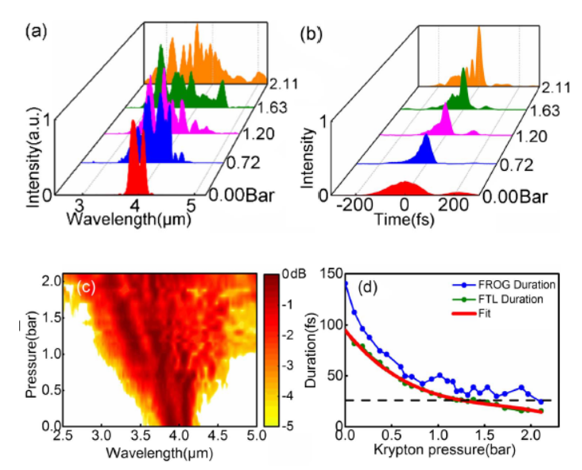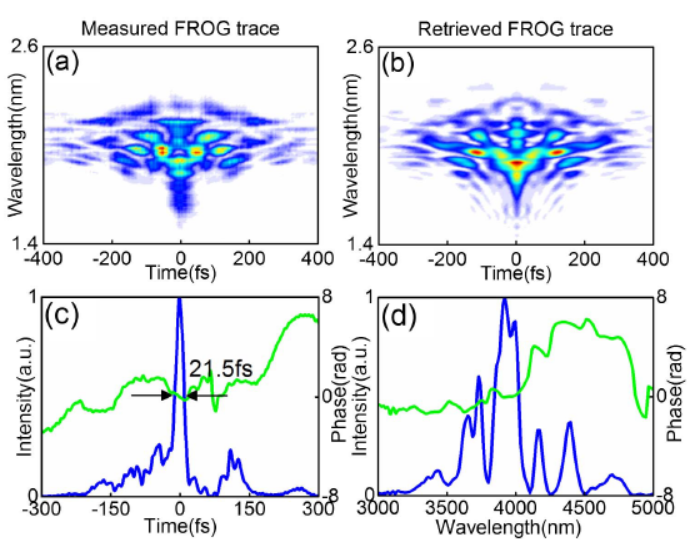High-energy few-cycle mid-infrared (MIR) laser source with carrier-envelope-phase (CEP)-stable are attractive for numerous applications, such as driving HHG in the keV range and isolated ultrashort coherent soft x-ray pulse generation.
Optical parametric amplification (OPA) and Optical parametric chirped pulse amplification (OPCPA) is the more commonly methods to generate tens of millijoule MIR pulse. However, neither OPA nor OPCPA can provide sufficient bandwidth to support delivering single-optical cycle M-IR pulses, which are typically limited by sub-100fs.
Recently, researchers of State Key Laboratory of High Field Laser Physics, Shanghai Institute of Optics and Fine Mechanics of the Chinese Academy of Sciences (CAS), employed a novel post-compression technique to generate mJ-level near-single-cycle pulses at 4 μm.
Based on OPCPA, the laser source first delivered about 12 mJ energy 50 ps pulse at 4 μm running at 100 Hz. Then, a grating pair compressor was used to compress the pulse duration to 105 fs. In order to further reduce the pulse duration to few optical cycles, a large diameter and 3 meter length krypton-filled hollow-core-fiber (HCF) was employed to broaden the spectrum spanning from 3000 nm to 5000 nm by strong SPM effect, which is broad enough to support single-cycle pulse generation. Following this, a 2-mm thick CaF2 plate was subsequently applied to introduce negative dispersion in order to compensate the positive chirp introduced by SPM. The pulse is re-compress to near-single-cycle duration in the CaF2 plate. The result shows, due to the mode selection effect of HCF, the beam profile quality is much better than initial beam profile. With appropriate energy and duration of input pulse and 1.15 bar krypton pressure in HCF, the 5.5mJ/140fs pulses were compressed down to 2.6mJ/21.5fs successfully.
This novel laser system demonstrates a series of splendid parameters simultaneously such as millijoule-level energy, near-single-cycle duration, stable CEP, excellent beam profile, long wavelength at 4 μm and high repetition frequency. It is one of the best laser system at 4 μm wavelength and is suitable for high-flux isolated ultrashort coherent soft x-ray pulse generation by driving HHG.
The details of this work, entitled “2.6mJ/100Hz CEP stable near-single-cycle 4μm laser based on OPCPA and hollow-core-fiber compression”, was published in Optics Letter.
This work was supported by The Strategic Priority Research Program of the Chinese Academy of Sciences, International S&T Cooperation Program of China and the Innovative Research Group of the National Natural Science Foundation of China.

Fig. 1. (a) Spectrum and (b) corresponding temporal profile measured by SHG-FROG at different krypton pressures. (c) Spectrum evolution throughout increasing gas pressure in HCF. (d) Pulse duration from SHG-FROG and Fourier-transform-limited duration of the spectrally broadened pulse for different krypton pressures

Fig. 2. Temporal characterizations of the compressed pulse. (a) Measured and (b) reconstructed SHG-FROG traces. (c) Pulse temporal profile of 21.5 fs FWHM duration and (d) reconstructed spectrum.